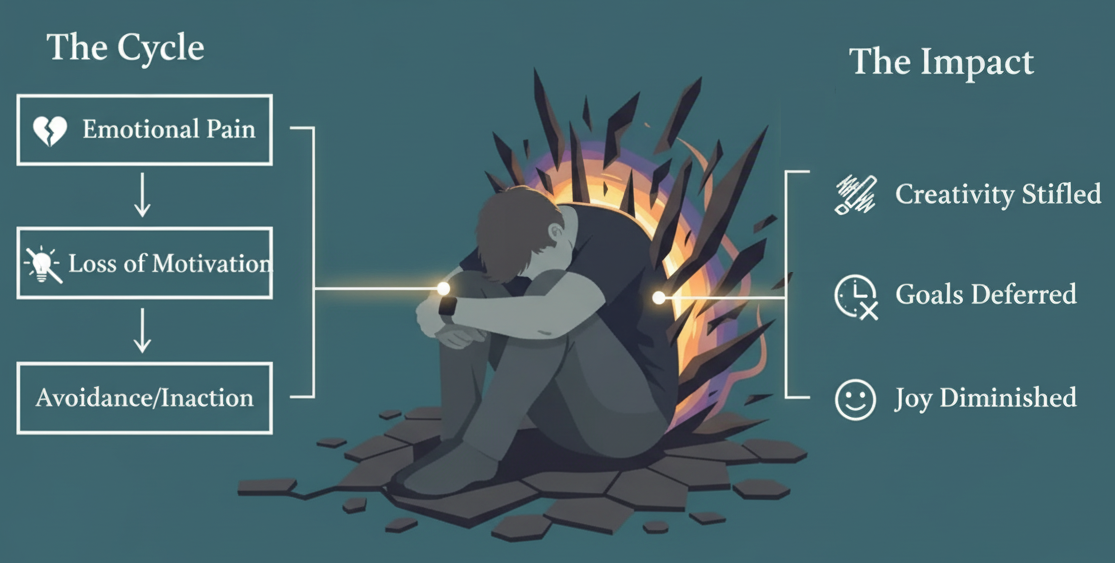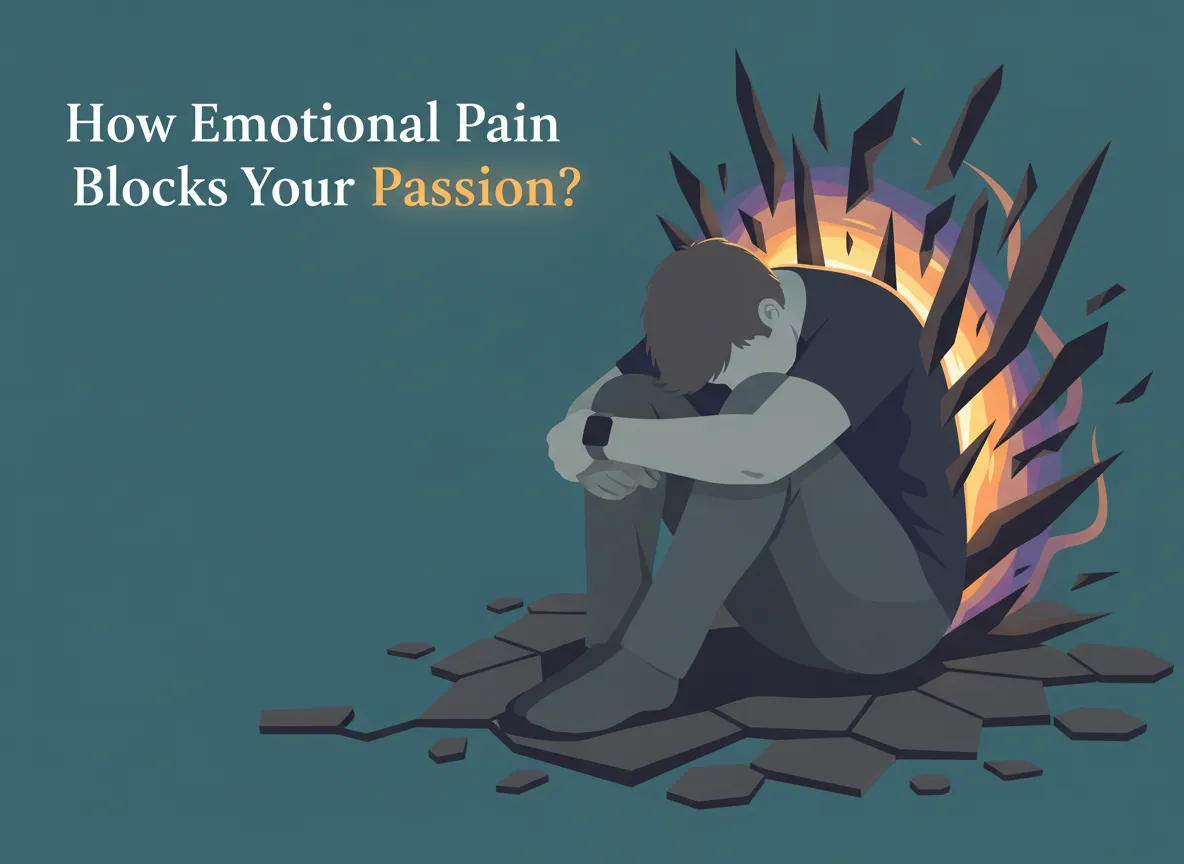Creativity is a powerful force. It’s what allows us to write, paint, sing, design, and solve problems in unique ways. For many people, creativity is also deeply tied to joy, meaning, and personal expression. But what happens when emotional pain gets in the way?
Many people experience creative blocks after going through heartbreak, stress, grief, or trauma. Activities that once felt exciting suddenly feel heavy. The spark disappears, leading to a loss of interest in passions that once brought happiness.
The good news is this: while emotional pain can dim creativity, it doesn’t erase it forever. Understanding the connection between emotions and creativity is the first step toward healing and reigniting your passion.
The Link Between Emotional Pain and Creativity:
Emotional pain affects the brain and body in powerful ways. When we go through stress, sadness, or trauma, our nervous system focuses on survival rather than exploration. This can block the natural flow of creative energy.
Here’s how emotional pain can lead to creative blocks:
Mental fatigue: Constant overthinking or worrying leaves little energy for creative exploration.
Fear of vulnerability: Creativity often requires openness and risk-taking. When we’re hurting, vulnerability feels unsafe.
Negative self-talk: Pain can trigger harsh inner voices that say, “You’re not good enough” or “Why bother?”—shutting down inspiration.
Loss of joy: Emotional struggles like depression or grief can create a loss of interest in hobbies, passions, and creative outlets.
Stress on the body: Emotional pain affects physical health too. Fatigue, headaches, and tension make it harder to focus on creative projects.
This is why mental wellness & creativity are closely linked. When our emotional health suffers, our creative flow often suffers too.
Why Creativity Matters for Healing?
Even though emotional pain can block creativity, creativity itself is also a powerful tool for healing. Engaging in art, music, writing, or other creative outlets allows us to process emotions that are hard to put into words.
Benefits of creativity for emotional healing include:
- Release of emotions: Creative expression gives pain an outlet.
- Stress relief: Activities like painting, journaling, or playing music calm the nervous system.
- Boosted self-esteem: Finishing a creative project, even a small one, creates a sense of achievement.
- New perspectives: Art helps us see challenges in different ways.
This means that while emotional pain can block creativity, creativity itself can become part of the solution.

Steps to Reignite Creativity After Emotional Pain:
Healing creative blocks takes time and patience. Here are some gentle steps to help you reconnect with your passion:
1. Allow Yourself to Rest:
Sometimes the best way to restart creativity is to take a break without guilt. Rest is not laziness—it’s recovery. Emotional wounds need space to heal before inspiration returns.
2. Start Small:
Instead of pressuring yourself to create a masterpiece, start with tiny acts of creativity. Doodle for five minutes, write a short journal entry, or take a photo of something beautiful. Small sparks can grow into bigger flames.
3. Create Without Judgment:
Perfectionism often worsens creative blocks. Remind yourself: it’s okay to create something messy or imperfect. The act of creating matters more than the outcome.
4. Use Creativity as Therapy:
Try writing about your feelings, painting your emotions with colors, or playing music that matches your mood. This blends creativity with healing, supporting both mental wellness & creativity.
5. Change Your Environment:
Sometimes a new setting inspires new ideas. Go for a walk, rearrange your workspace, or visit a place that sparks curiosity. Fresh surroundings can shift your mindset.
6. Connect with Supportive People:
Join a group, workshop, or community where creativity is encouraged. Being around others can motivate you and remind you that you’re not alone in your struggles.
7. Practice Self-Compassion:
Talk to yourself kindly. Instead of saying, “I should be more creative,” try, “I’m giving myself time to heal, and creativity will return when I’m ready.”
Reframing Creative Blocks:
Instead of seeing creative blocks as a failure, try viewing them as signals. They often mean your mind and body are asking for attention. Maybe you need rest, healing, or new inspiration.
Think of creative blocks not as walls but as pauses—moments where your energy is gathering strength for new ideas. This mindset shift can reduce frustration and keep hope alive.
When to Seek Extra Help:
Sometimes, creative blocks are tied to deeper issues like depression, anxiety, or unresolved trauma. If you’ve been feeling a long-term loss of interest in activities you once loved, it may help to talk with a mental health professional. Therapy can support both mental wellness & creativity, helping you process emotions and unlock new pathways to self-expression.
Hope for Reigniting Passion:
Emotional pain may temporarily silence your creativity, but it can never erase it completely. Creativity is part of being human—it lives within you, waiting to resurface when the time is right.
By allowing yourself to heal, starting small, and reconnecting with joy, you can reignite your creative spark. Over time, the very pain that blocked your passion may even inspire deeper, more meaningful creative work.
Final Thoughts:
Emotional pain can create creative blocks, cause a loss of interest in passions, and leave you feeling disconnected from your spark. But creativity is resilient. With patience, rest, and gentle practices, you can begin to heal and rediscover your passion.
Remember: your creativity is still within you, even when it feels hidden. As you nurture both mental wellness & creativity, you’ll find that inspiration slowly returns—often in surprising and beautiful ways.


